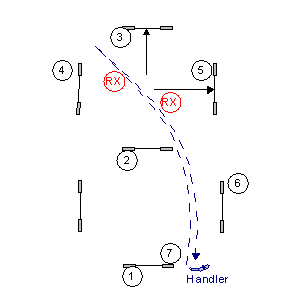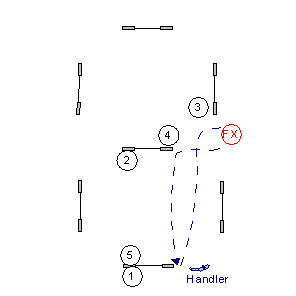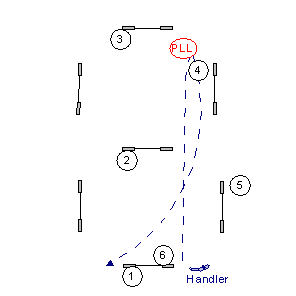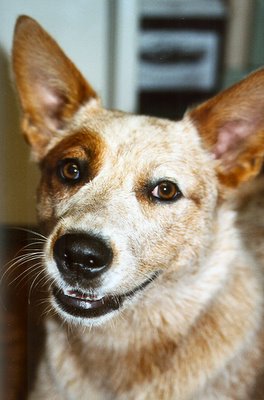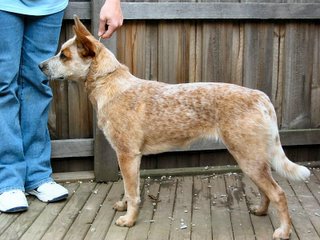December 31, 2005
No Cookie No Doie
Thinking about what becomes part of the cue, I went back to Sue Ailsby's training plan to fade treats and clicker from the equation. Sue says:
"Go to your most common training location with your clicker and maybe 15 treats. Put 10 treats on a table 5' away from you. Put 10 treats on a table 10' away from you, and put the rest on a table in the next room. Keep your clicker. Work on Sit from scratch until she's offering it to you eagerly and you've used up your initial handful of treats. Without any break, ask her for a Sit. Click, and go fast and happily to the closest table, get a treat and hand it to her. Make a pretty big deal of this. Go back to your training place, ask for another Sit, click and go back to the table to get a treat. Finish up the treats this way.
Now, seamlessly, go back to the training place and ask for another Sit. Click, and go to the 10' table. Continue until you've used those ten treats up, then work with the ones in the next room. Lots of work for you, running back and forth, but worth it to get the dog to trust that there will be a treat, even if she can't see one.
When you've run through that routine several days in a row, do the same thing again, but don't take your clicker into the game. Where you would have clicked, now you're going to use a word instead. I use YES! "
So that was today's game. I know there are trainers who say that the click must always immediately be paired with the re-inforcement or it will lose its 'charge'. But the click means what you teach the dog it means. And as Sue explains it, as the treat becomes more removed from the behaviour/click you replace the click with a word.
December 28, 2005
Swim training
Dusty played at the waters edge, but showed no desire to go in herself. So once the weather warmed up, I started going in myself and just standing about or doing a few strokes parallel to the beach. Duz would swim out to me with a look of grim determination.
Last week I started throwing Thommo's ball or stick out into the water for him to fetch and then running in after him calling Dusty. She followed us quite happily. This morning I didn't go in beyond my knees, but when I threw the ball for Thommo I called Duz. After a few goes, she was swimming out after him without any encouragement.
I think swimming is great exercise for them, and we can swim every day without effort, so I'm thrilled that she has decided she likes it.
December 23, 2005
December 21, 2005
Box Drills
However sometimes I do want to practice a particular handler movement, and for this I have some set sequences using the double box. These come from my notes from a Greg Derrett seminar, so there is a risk that I have misquoted or misinterpreted. The usual consumer cautions apply :-)
Front Cross
Rear Cross
Push Through
Pull Through
December 20, 2005
Contact
December 18, 2005
Puppy agility

Originally uploaded by Turtblu.
Found a photo of the cute red pup doing agility. Her name is Laika and this is a shot of her starting a run at the final class day of Puppy-agility, 4 months old.
Not sure about the guiding hand though. I'd be just standing there and letting her choose to go in the tunnel and rewarding her when she did.
Flickr red puppy
December 16, 2005
On your spot
Today my criteria is going to whatever target I indicate (mouse pad, bathmat, folded dog rug, crate pad) and waiting in a down for 5 - 10 seconds and I'm rewarding with a thrown toy to keep her focused out in front and to build drive from the target.
I realised that I don't often follow a click with a toy rather than food, so I'll try doing some more of that - pairing the click with a wider range of reinforcers. I have tried to get her playing a lot of different games with all sorts of things. Thommo I allowed to become obsessive over a tennis ball - he doesn't even like other sorts of balls.
December 13, 2005
Contact Behaviour
But is this what we really want? Don't we want the shoulders flexed ready to absorb impact? If a dog has his nose to the ground do we achieve that? Or is his weight now forward? If the dog were in the same position, shoulders low but head UP would more weight be forward or back?
Thommo tends to bring his head up to slow down, transferring his weight to his hindquarters; and to drop his head to accelerate, shifting his weight to his forequarters to drive off. This is the reverse of what a nose touch asks for on the contacts.
Almost every fibre in my body tells me that if Susan uses a particular method then it must be the best method - but there is one fibre that wonders whether a nose touch can really be best, particularly when Susan describes Buzz getting nose bleeds from the intensity with which he touches.
Another contact behaviour that seems preferable is the chin press. In order to press his chin to the ground the dog has to ease back, not bend forward. Also the chin press is a stationary behaviour, more easily marked and rewarded. And it doesn't involve the dog trying to breathe with his nostrils smushed into the dirt. An example of a chin press rom Greg Fontaine's dog Maverick - http://www.geocities.com/chinpress/chinpress004.wmv
There is also the down at the end of the ramp, the running contact, and the one rear toe on. We'll continue working the necessary pre-obstacle skills and make a decision later before we get to the equipment.
Targeting
However, I am beginning to think that for many people the problem that their dogs have with contacts in a trial - as opposed to training - comes back to the cue for the behaviour. In a trial situation it may be that the problem is that the dog is waiting for what it thinks the cue is for the behaviour. And this might be quite different from what we think we have trained.
This was demonstrated rather well by Greg Derrett when he asked us all what our start line release cue was and for many (most?) dogs it was something quite different. So while we thought 'Go!' was the release, Rover thought that it was the word go said after mum stops looking at me, drops her arm and takes a running step.
It could be that correct performance on the contact is cued by a similar chain. Rover has learned his lesson well, "I stop with 2 feet on and 2 feet off when I can see that clear square thing , and mum sort of leans over the end of the board and points, and she has her other hand in the treat bag, and she says 'touch' in that smiley way she has when she is happy with me." If any of these elements are missing then it is not the cue for 2o2o.
The behaviour was not on stimulus control before it was transferred to the contact obstacle. We’re so pleased the dog is nose-touching the target, stopping 2o2o, dropping on a target, we move on to doing on the equipment long before the dog recognises the cue for the behaviour. What we need to establish is that Rover knows (and we know) the specific cue for the behaviour sufficiently well to perform it in a variety of circumstances.
With Dusty I'm working on a number of pre-contact obstacle skills. I haven't yet decided what her contact behaviour will be, I'll watch her and see if there is a natural behaviour that I can put on cue. With Thommo, the worrywart, I had to be careful not to do anything that he would interpret as a reproach so we didn't use a stop. I clicker trained him to run to the very end of any board, plank, steps, ramp, children's slide, skate pipe ... without jumping off. He has only ever missed a contact in one event.
I've been working this with Dusty too. We started with just a board flat on the floor, rewarding for going all the way to the end, and on a low wall in the park. Yesterday in the skate park she was doing great runs up quite a steep quarter pipe, and then running back down. I'd click as she got to the level area and drop a treat at her feet. After a few repeats she was running fast back to the end of the slope and stopping for her treat.
This morning I set up a hinged board across my ottoman, and encouraged Duz to jump up onto the ottoman. I then rewarded her for running down the sloping board to the end. At first I just clicked as she got to the end of the board, later I clicked when she paused at the end.
I hadn't done any work with a foot target with Dusty. But after working with her and the board I put a mouse pad on the floor for Thommo to earn some treats. On 'spot' he ran to the pad put one foot on and came back for his treat. Duz was just waiting, watching the treats (learning that even if treats are around she doesn't necessarily get one). Thommo touches the pad three times, three treats. Dusty then runs across, does a perfect one paw touch and comes back for her treat.
Entertained, I then called a name before saying 'spot' and tossed the treat in opposite directions for each dog, to give the other time to get to the target. When I thought the name had become part of the cue I made it harder, getting them to wait for their turn. A touch without a cue didn't get a reward. Dusty picked it up as quickly as Thommo.
Not sure how useful this will be, but it was fun.
December 11, 2005
Death of a Pet
I was grateful for the support of the agility community at the time. My social friends' and relatives' response was "Oh pity, but you'll get another dog?" It was only my dog-lover friends who could offer real sympathy and advice.
Greg Derrett lost Jaycee to cancer in October. I felt I knew her from Greg's videos and from how her talked of her in his seminars.
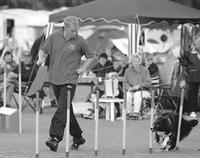 Greg supervises Jaycee Sproglett through the weaves.
Greg supervises Jaycee Sproglett through the weaves.
December 08, 2005
Advent Calendar
While you are there check out the party games and the glossary of agility terms.
The Zen of Dog
Letter 1
My dear puppy,
I have nothing to teach you, save a few basics
like sit, stay and heel, all meant to protect you
from the occasional folly of a careless man.
You, on the other hand, by nature are the very embodiment
of essential happiness and unconditional love.
Let me open my heart and embrace your instincts.
Teach me dog.
Tricks of the Trade
- leather kennel leads,
- grooming table with a low crossbeam,
- sturdy, hinged grooming arm.
Chapter two looks at puppy evaluations, saying that a breeder's goal should be to breed for:
The evaluation process consists of:
- For structure, evaluate puppies only at eight weeks, give or take three days either way.
- Evaluate the whole litter.
- Keep a written record of each evaluation.
- Select an objective grading system.
- Evaluate puppies at a place completely unfamiliar to them.
- Have someone unfamiliar to the puppies handle them for the evaluation.
- Evaluate puppies in a mirror.
- Let your fingertips be your best set of eyes.
- Be consistent in your evaluation steps: check temperament, look at the puppy in a suspended position, look at the whole puppy in a standing position, look for overall balance, check proportions, evaluate nutritional effects on structure.
Pat emphasises the value of good nutrition, but says that 'good' nutrition does not mean high powered puppy formula with supplements. Over feeding is as dangerous as underfeeding, she says in the chapter on nutrition, and that the food that keeps your adult dogs in good condition is safe to feed to your puppies from day one.
The last chapters of the book deal with 'teaching' rather than 'training' - puppies grow up more confident if the are taught to think for themselves rather than follow routines - with general management tips in caring for a show dog - professional handlers win because they take better care of the dogs than owners do - with displaying the dog's structure in the show ring - the appearance of a show dog is created by head and neck carriage - with grooming - the best groomed dogs at a show should be the agility dogs, becuse they are the ones that the public watches - and with presenting the dog's attributes in advertising for sale.
December 07, 2005
Pat Hastings
Another Piece of the Puzzle is a collection of articles, by authors including Pat, Brenda Aloff and Karen Pryor, on puppy development from the pre-natal period to maturity. The book has lots of practical information and advice including invaluable Tips and Tricks for breeders and owners. In the puppy training issue of Clean Run (V10, N5) Pat talks about structure in the agility puppy.
The Puppy Puzzle video and evaluation forms provide a framework for assessing the structure, presentation and temperament of puppies at around eight weeks old.
Tricks of the Trade discusses all of the elements that go to make up a winning performance in the show ring, which is the sum of effective breeding, evaluating, rearing, teaching, conditioning, nutrition, grooming, care and presentation. Again, what I love about this book are the dot point tips such as "To give your dog an advantage in the ring, always lead it through a stretching exercise before showing" and "When bathing a dog that has stains use only lukewarm water. Hot or cold water will set the stains."


